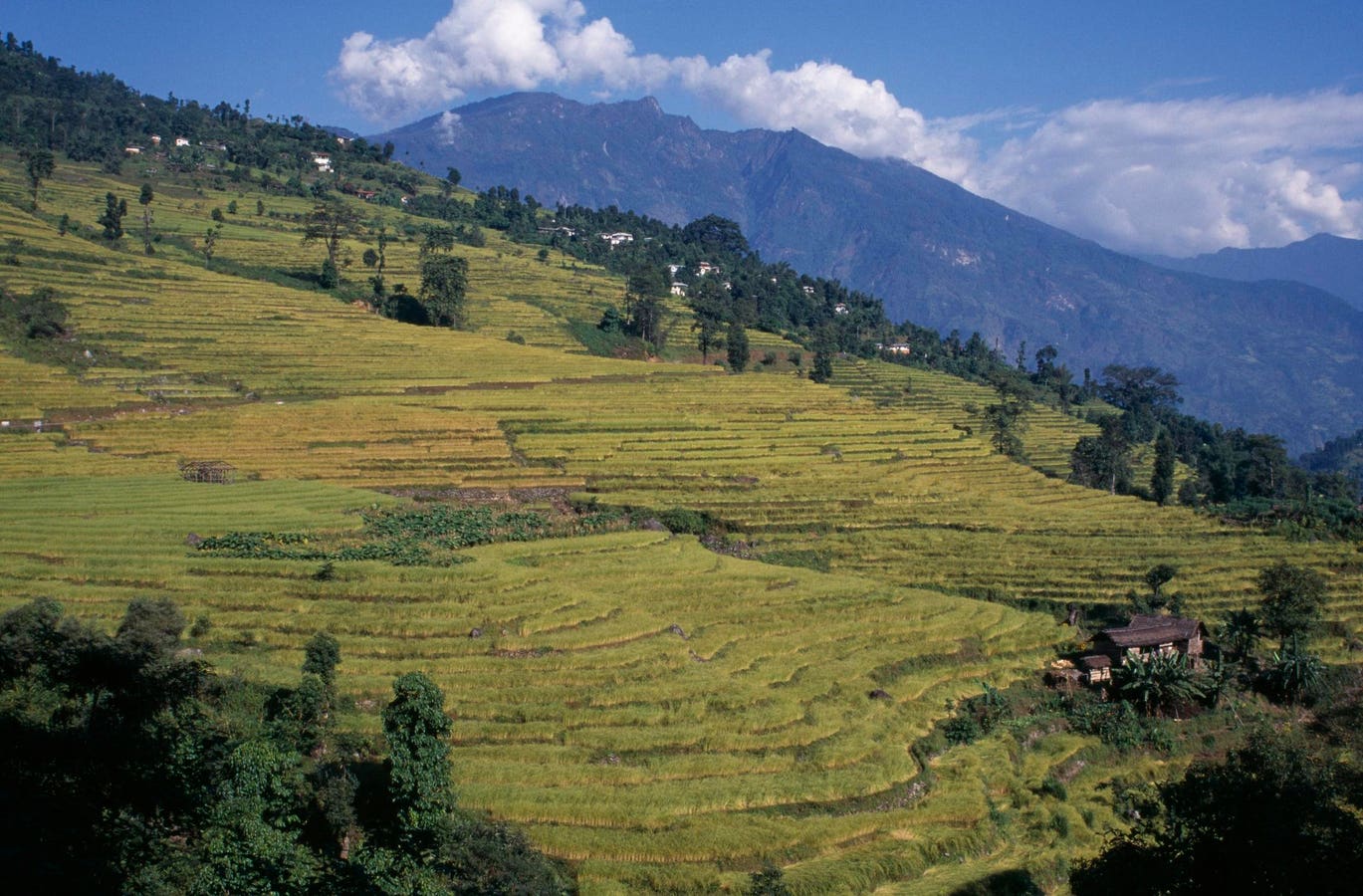Rice terraces on a hillside in West Sikkim, India. (Photo by: Eye Ubiquitous/Universal Images Group … More
Organic farming has gathered pace in the last few years, with 98.9 million hectares being managed organically across the world by the end of 2023, according to The Organic Research Centre. This was a 2.6% or 2.5 million hectares rise from the previous year.
India is the second-largest country worldwide in terms of organic farmland, at about 4.5 million hectares, after Australia, which has 53 million hectares.
Sikkim, a small Himalayan state in northeast India became the world’s first fully organic state in 2016, with all agricultural activities being carried out without the use of chemical pesticides or fertilizers.
This was done through a set of highly-focused initiatives that started back in 2003, mainly implemented to improve public health, protect the environment and boost sustainable farming practices. According to FuturePolicy.org, the state currently has more than 76,000 hectares of organic farmland.
Sikkim was awarded the Future Policy Gold Award by the United Nations Food and Agricultural Organization (FAO) in 2018, to recognize the state as a global leader in organic agriculture.
It produces grains such as maize, rice, wheat, millet, barley and a variety of spices including ginger, large cardamom and turmeric, along with fruits such as apples, oranges and bananas and vegetables like kale and spinach.
But how did Sikkim achieve its fully organic status and can its agricultural practices be applied to the rest of India?
How did Sikkim become the world’s first fully organic state?
Sikkim became the world’s first fully organic state by launching a series of coordinated policies. The Sikkim Organic Mission, launched in 2010, aimed to fast-track the conversion of all agricultural land to organic by December 2015.
Establishing the Sikkim State Organic Board in 2003 to develop strategies, policies and standards for organic farming was another key action.
One of the most important actions taken was phasing out and eventually banning chemical fertilizers and pesticides.
This was done by gradually increasing taxes on chemical pesticides and fertilizers, while also stopping imports of synthetic pesticides, fertilizers and non-organic vegetables from outside the state. Subsidies for farmers using these synthetic fertilizers and pesticides stopped as well.
Dr. Jennifer Brandon, environmental scientist and sustainability consultant at Wild Beacon Consulting, highlighted in an interview: “The government also supported the production and use of organic fertilizers and organic seeds, and created comprehensive capacity building, including training the farmers in new ecological agriculture techniques and adding organic farming to school curriculum.”
Organic farming methods used by Sikkimese farmers include soil management practices such as composting using compost manure and cow dung and vermiculture, in which earthworm manure is used to enhance nutrient content and soil fertility.
Green manuring, which uses legumes and other crops is employed too, along with mulching with a variety of organic materials to regulate temperature and retain soil moisture.
Pest management is mainly carried out through crop rotation, which disturbs pest cycles and improves soil health, as well as using botanical pesticides like garlic extracts and neem oil. Intercropping, which is growing different crops together, can also decrease agricultural pest problems.
Other crop diversity techniques such as crop rotation and using indigenous seeds can help keep pests at bay as well while maintaining genetic diversity and soil fertility.
Sikkim’s government has ensured that there is a market to buy the organic produce, through organic retail outlets, while also promoting sustainable tourism.
All farms in Sikkim have been certified according to international standards facilitated by the Sikkim State Organic Certification Agency (SSOCA). The state has focused more on consumer awareness and education, while continuously monitoring the progress of this organic transition and making necessary changes.
Key legislation has played a major role in speeding up the adoption of organic farming in Sikkim.
Professor Himanshu Rai, director of Indian Institute of Management, Indore, said in an interview: “To support the transition, the government passed key legislation like the Sikkim Agriculture, Horticulture, and Livestock Feed Regulatory Act (2014) and developed infrastructure such as biofertilizer production units.”
Can Sikkim’s actions be applied to the rest of India?
Sikkim’s agricultural methods can be applied to the rest of India but not without significant government or philanthropic help.
Brandon explained: “The first transition from synthetic fertilizer and seeds to organic fertilizer and seeds can be expensive, and having the government or another third party help in that transition is key.”
One of the main reasons this transition was successful in Sikkim was because of the tax incentives in place, which promoted the use of organic fertilizers.
If Sikkim’s practices were to be replicated throughout India, a similar national incentive structure for using organic fertilizer and seeds may be needed, at least for the first season. Simultaneously, taxes may have to be raised on chemical pesticides and fertilizers.
Praveena Sridhar, the CTO of Save Soil, said: “Transitioning to organic farming might lead to yield loss initially. Farmers will have to be adequately incentivized, either directly as financial assistance or through subsidies on infrastructure, to compensate for this yield loss.”
Other incentive mechanisms like assured market prices and crop insurance may also need to be implemented.
An in-depth farmer training program on organic agricultural practices would be required, which may need to be supported by a technologically sound hand-holding mechanism, ideally synced with specific Indian regions’ crop calendars.
In terms of market development, although there are many online platforms to sell organic goods in India, a dedicated market mechanism for organic farming, such as the Agricultural Produce Market Committees for traditional farming, is yet to be established.
“Promoting investment in infrastructure for organic farming, including cold storage, processing facilities and marketing channels for organic produce should be the priority,” Sridhar explained.
Another important initiative should be farmer producer companies and collectives, which will help farmers pool their resources, enable better market access and enhance negotiating power.
Additionally, an internationally recognized organic standard, to make trade easier and increase the acceptance of Indian organic produce may be required. Such an agency could also create more localized and flexible certification systems, which may be more suitable for small and medium-sized farmers.
Although applying Sikkim’s agricultural practices to the rest of India could be complicated and time-consuming, the state has proved that there is significant money to be made in organic farming.
“It pays off to invest in sustainable agriculture. Sikkim’s transition to a fully organic state has benefited over 66,000 farmers,” Sridhar noted.
This change has helped Sikkim, once one of the poorest states in India, become one of the wealthiest at the moment. It has also elevated the lifestyle, literacy rate and life expectancy rate of Sikkimese people as well.
“Organic farming is good for the soil, it’s good for the watershed and it’s good for your health,” Brandon said.
Low initial yields continue to slow organic farming
Despite the benefits of organic farming, challenges remain when it comes to large-scale implementation.
One of the biggest hurdles is low initial yields when transitioning from traditional farming to organic farming. According to Sridhar, these can be as low as 50% to 60% in certain cases. This, combined with long transition periods, which can last a few years, increase the need to provide financial security nets to farmers.
Sridhar highlighted: “Carefully designed farming models, taking into account the local agroecological considerations need to be formulated to make this transition period sustainable and profitable for the farmer.”
Labor costs are also much higher in organic farming compared to traditional farming due to the practice being more labor-intensive. A lack of skilled labour in organic farming adds to these high costs as well.
Similarly, access to regenerative agricultural farming equipment can be fairly limited in some areas, along with services such as customer support, input manufacturing units and dedicated markets for organic farming.
For larger farms, obtaining and maintaining organic certification can often be very expensive, with long, complex processes involving maintaining high volumes of farm management data.
In the Indian context, part of why organic farming works in Sikkim, according to Brandon, is because the state is very small and can charge more for organic produce because it is outcompeting other nearby farming regions.
“If the entire country was organic, it may be harder to continue to charge those organic premium prices, although they still could be charged for certain specialty crops or exports,” Brandon noted.








